Financial Management Assignment: Share Issuance and Capital Budgeting
VerifiedAdded on 2022/09/28
|18
|3619
|22
Homework Assignment
AI Summary
This document presents a comprehensive solution to a Financial Management assignment, addressing two key questions. The first question focuses on share issuance, analyzing three options with different price rates and calculating the theoretical ex-rights fair value per share and expected EPS. It evaluates the best option for the company, recommending the most beneficial share issuance strategy. The second question delves into capital budgeting, utilizing tools such as ARR, IRR, NPV, and payback period to evaluate the economic feasibility of a machine investment. It provides detailed calculations, discusses the machine's economic viability, and explores the benefits and limitations of various investment appraisal techniques, including NPV and IRR. The assignment offers a practical application of financial concepts and decision-making processes.

Financial Management
Paraphrase This Document
Need a fresh take? Get an instant paraphrase of this document with our AI Paraphraser
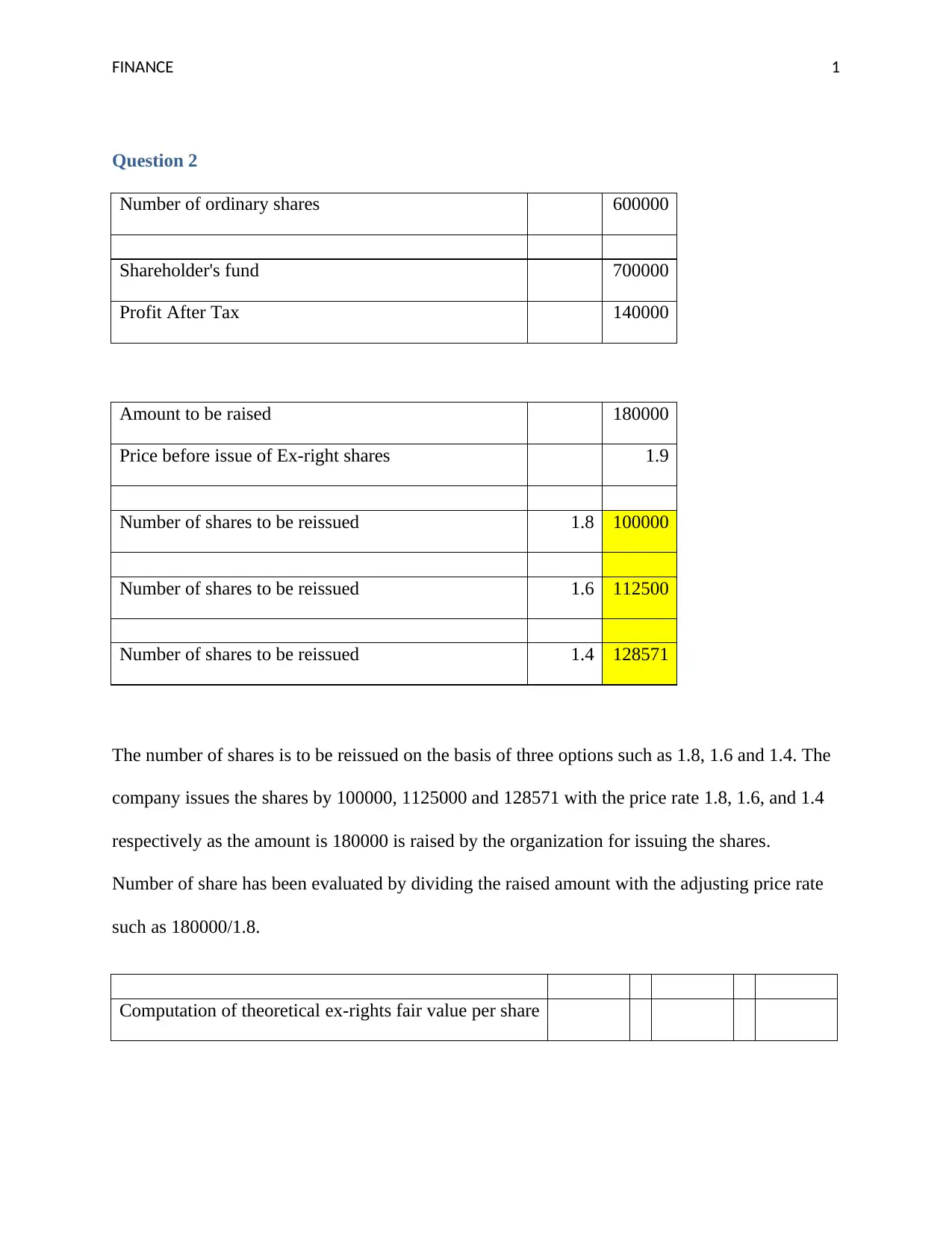
FINANCE 1
Question 2
Number of ordinary shares 600000
Shareholder's fund 700000
Profit After Tax 140000
Amount to be raised 180000
Price before issue of Ex-right shares 1.9
Number of shares to be reissued 1.8 100000
Number of shares to be reissued 1.6 112500
Number of shares to be reissued 1.4 128571
The number of shares is to be reissued on the basis of three options such as 1.8, 1.6 and 1.4. The
company issues the shares by 100000, 1125000 and 128571 with the price rate 1.8, 1.6, and 1.4
respectively as the amount is 180000 is raised by the organization for issuing the shares.
Number of share has been evaluated by dividing the raised amount with the adjusting price rate
such as 180000/1.8.
Computation of theoretical ex-rights fair value per share
Question 2
Number of ordinary shares 600000
Shareholder's fund 700000
Profit After Tax 140000
Amount to be raised 180000
Price before issue of Ex-right shares 1.9
Number of shares to be reissued 1.8 100000
Number of shares to be reissued 1.6 112500
Number of shares to be reissued 1.4 128571
The number of shares is to be reissued on the basis of three options such as 1.8, 1.6 and 1.4. The
company issues the shares by 100000, 1125000 and 128571 with the price rate 1.8, 1.6, and 1.4
respectively as the amount is 180000 is raised by the organization for issuing the shares.
Number of share has been evaluated by dividing the raised amount with the adjusting price rate
such as 180000/1.8.
Computation of theoretical ex-rights fair value per share

FINANCE 2
132000
0
132000
0 1320000
700000 712500 728571
1.88571 1.85263 1.81176
Ex-rights fair value per share has been evaluated with this formula:
Fair value of all outstanding shares immediately prior to exercise of rights shares issued in the
exercise +Total amount received from exercise
Number of shares outstanding prior to exercise+ Number of shares issued in the Exercise
(Xplained, 2014)
As per the evaluation, 1.88, 1.85 and 1.877 are the Ex-rights fair value per share with the 1.8, 1.6
and 1.4 price rates respectively.
Computation of adjustment
facto
Fair value per share prior to exercise of
rights
Theoretical ex-rights value per share
1.9 1.9 1.9
1.88571
1.8526
3
1.8117
6
1.00758 1.0255 1.0487
132000
0
132000
0 1320000
700000 712500 728571
1.88571 1.85263 1.81176
Ex-rights fair value per share has been evaluated with this formula:
Fair value of all outstanding shares immediately prior to exercise of rights shares issued in the
exercise +Total amount received from exercise
Number of shares outstanding prior to exercise+ Number of shares issued in the Exercise
(Xplained, 2014)
As per the evaluation, 1.88, 1.85 and 1.877 are the Ex-rights fair value per share with the 1.8, 1.6
and 1.4 price rates respectively.
Computation of adjustment
facto
Fair value per share prior to exercise of
rights
Theoretical ex-rights value per share
1.9 1.9 1.9
1.88571
1.8526
3
1.8117
6
1.00758 1.0255 1.0487
⊘ This is a preview!⊘
Do you want full access?
Subscribe today to unlock all pages.

Trusted by 1+ million students worldwide

FINANCE 3
7
The computation of adjustment factors state that the fair value per share is 1.9 and ex-rights
value per share is 1.88, 1.85 and 1.81 respectively.
Expected EPS Net Profit After Tax
Weighted average number of shares
140000 140000 140000
604545 615341 629221
0.23158 0.22752 0.2225
The company has 140000 as the net profit after tax. Weighted average number of shares has been
evaluated by the amount of issuing shares multiple by ex-rights value per share. At the end
expected EPS are 0.23, 0.22 and 022 on 1.8, 1.6 and 1.4 respectively.
V.
In the above evaluation, there are three options of rate of issuing the shares. The organization has
to evaluate the EPS with all three options in order to select the best option. There are three price
rates that the organization use to issues the shares and these are 1.8, 1.6, and 1.4. There are three
options and those are discussed below in detail:
The amount of capital that the company raised for issuing shares is 1,80,000.
Option A
7
The computation of adjustment factors state that the fair value per share is 1.9 and ex-rights
value per share is 1.88, 1.85 and 1.81 respectively.
Expected EPS Net Profit After Tax
Weighted average number of shares
140000 140000 140000
604545 615341 629221
0.23158 0.22752 0.2225
The company has 140000 as the net profit after tax. Weighted average number of shares has been
evaluated by the amount of issuing shares multiple by ex-rights value per share. At the end
expected EPS are 0.23, 0.22 and 022 on 1.8, 1.6 and 1.4 respectively.
V.
In the above evaluation, there are three options of rate of issuing the shares. The organization has
to evaluate the EPS with all three options in order to select the best option. There are three price
rates that the organization use to issues the shares and these are 1.8, 1.6, and 1.4. There are three
options and those are discussed below in detail:
The amount of capital that the company raised for issuing shares is 1,80,000.
Option A
Paraphrase This Document
Need a fresh take? Get an instant paraphrase of this document with our AI Paraphraser
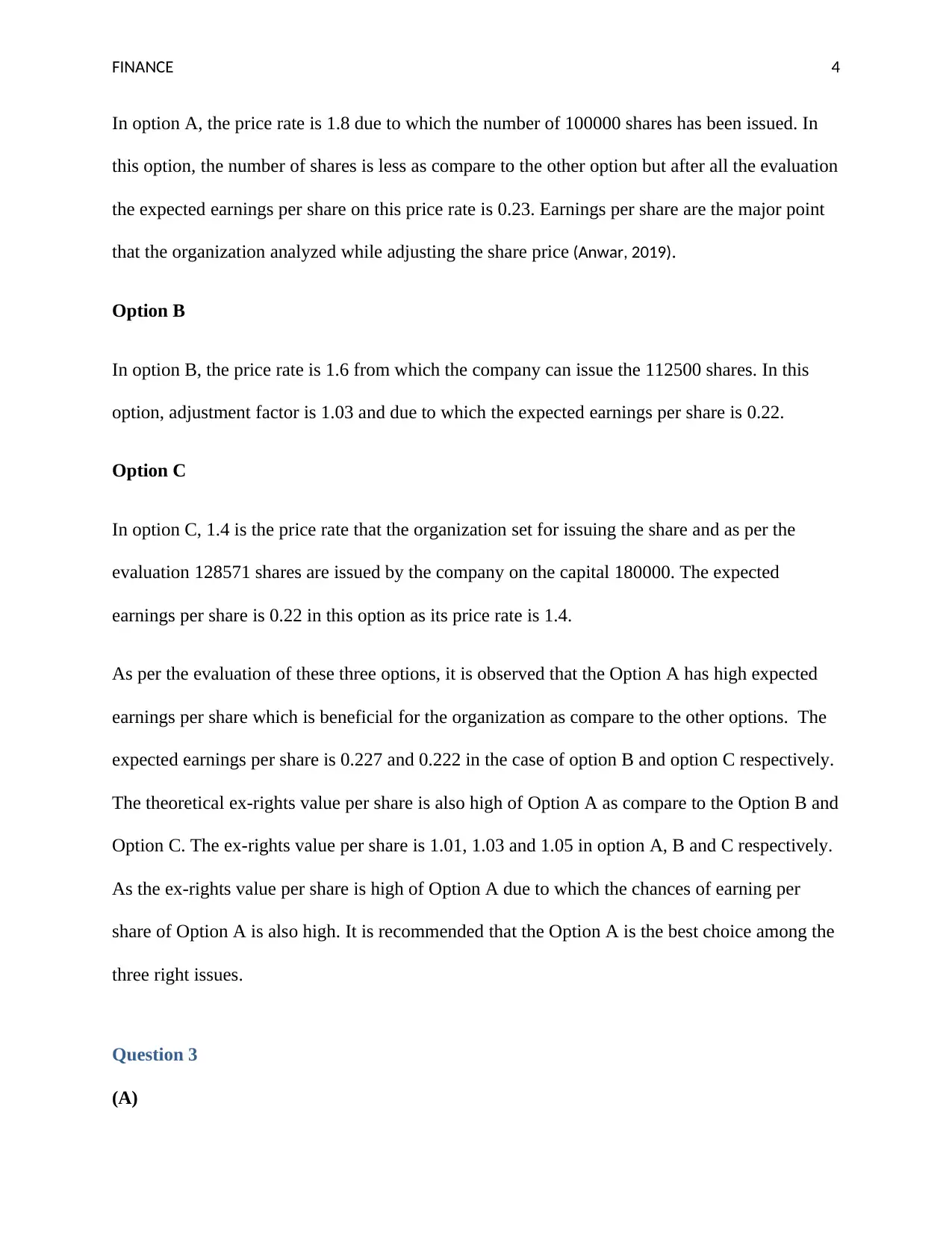
FINANCE 4
In option A, the price rate is 1.8 due to which the number of 100000 shares has been issued. In
this option, the number of shares is less as compare to the other option but after all the evaluation
the expected earnings per share on this price rate is 0.23. Earnings per share are the major point
that the organization analyzed while adjusting the share price (Anwar, 2019).
Option B
In option B, the price rate is 1.6 from which the company can issue the 112500 shares. In this
option, adjustment factor is 1.03 and due to which the expected earnings per share is 0.22.
Option C
In option C, 1.4 is the price rate that the organization set for issuing the share and as per the
evaluation 128571 shares are issued by the company on the capital 180000. The expected
earnings per share is 0.22 in this option as its price rate is 1.4.
As per the evaluation of these three options, it is observed that the Option A has high expected
earnings per share which is beneficial for the organization as compare to the other options. The
expected earnings per share is 0.227 and 0.222 in the case of option B and option C respectively.
The theoretical ex-rights value per share is also high of Option A as compare to the Option B and
Option C. The ex-rights value per share is 1.01, 1.03 and 1.05 in option A, B and C respectively.
As the ex-rights value per share is high of Option A due to which the chances of earning per
share of Option A is also high. It is recommended that the Option A is the best choice among the
three right issues.
Question 3
(A)
In option A, the price rate is 1.8 due to which the number of 100000 shares has been issued. In
this option, the number of shares is less as compare to the other option but after all the evaluation
the expected earnings per share on this price rate is 0.23. Earnings per share are the major point
that the organization analyzed while adjusting the share price (Anwar, 2019).
Option B
In option B, the price rate is 1.6 from which the company can issue the 112500 shares. In this
option, adjustment factor is 1.03 and due to which the expected earnings per share is 0.22.
Option C
In option C, 1.4 is the price rate that the organization set for issuing the share and as per the
evaluation 128571 shares are issued by the company on the capital 180000. The expected
earnings per share is 0.22 in this option as its price rate is 1.4.
As per the evaluation of these three options, it is observed that the Option A has high expected
earnings per share which is beneficial for the organization as compare to the other options. The
expected earnings per share is 0.227 and 0.222 in the case of option B and option C respectively.
The theoretical ex-rights value per share is also high of Option A as compare to the Option B and
Option C. The ex-rights value per share is 1.01, 1.03 and 1.05 in option A, B and C respectively.
As the ex-rights value per share is high of Option A due to which the chances of earning per
share of Option A is also high. It is recommended that the Option A is the best choice among the
three right issues.
Question 3
(A)

FINANCE 5
There are many capital budgeting tools that the organization used to evaluate the projects of
investments in order to take the best decision to earn the high profit (Kengatharan, 2016). The best
option for the organization in investment is one from which the company earns the high revenue
and gets the high amount of return. In this question, ARR (Accounting Rate of Return), IRR
(Internal Rate of Return), NPV (Net present value) and Payback period are the methods of
capital budgeting have been used to evaluate the best option among the other option in
investment projects.
Given Data
Cost 320000
64000
Residual value 32000
Cost of Capital 12%
Years 0 1 2 3 4 5 6
Initial capital
outcomes -320000
Cash Inflow 105000 105000
10500
0
10500
0
10500
0
10500
0
Cash outflows 15500 15500 15500 15500 15500 15500
Annual Cash
Flows 89500.00 89500.00
89500.
00
89500.
00
89500.
00
89500.
00
Discounting factor 1.000 0.893 0.797 0.712 0.636 0.567 0.507
There are many capital budgeting tools that the organization used to evaluate the projects of
investments in order to take the best decision to earn the high profit (Kengatharan, 2016). The best
option for the organization in investment is one from which the company earns the high revenue
and gets the high amount of return. In this question, ARR (Accounting Rate of Return), IRR
(Internal Rate of Return), NPV (Net present value) and Payback period are the methods of
capital budgeting have been used to evaluate the best option among the other option in
investment projects.
Given Data
Cost 320000
64000
Residual value 32000
Cost of Capital 12%
Years 0 1 2 3 4 5 6
Initial capital
outcomes -320000
Cash Inflow 105000 105000
10500
0
10500
0
10500
0
10500
0
Cash outflows 15500 15500 15500 15500 15500 15500
Annual Cash
Flows 89500.00 89500.00
89500.
00
89500.
00
89500.
00
89500.
00
Discounting factor 1.000 0.893 0.797 0.712 0.636 0.567 0.507
⊘ This is a preview!⊘
Do you want full access?
Subscribe today to unlock all pages.

Trusted by 1+ million students worldwide
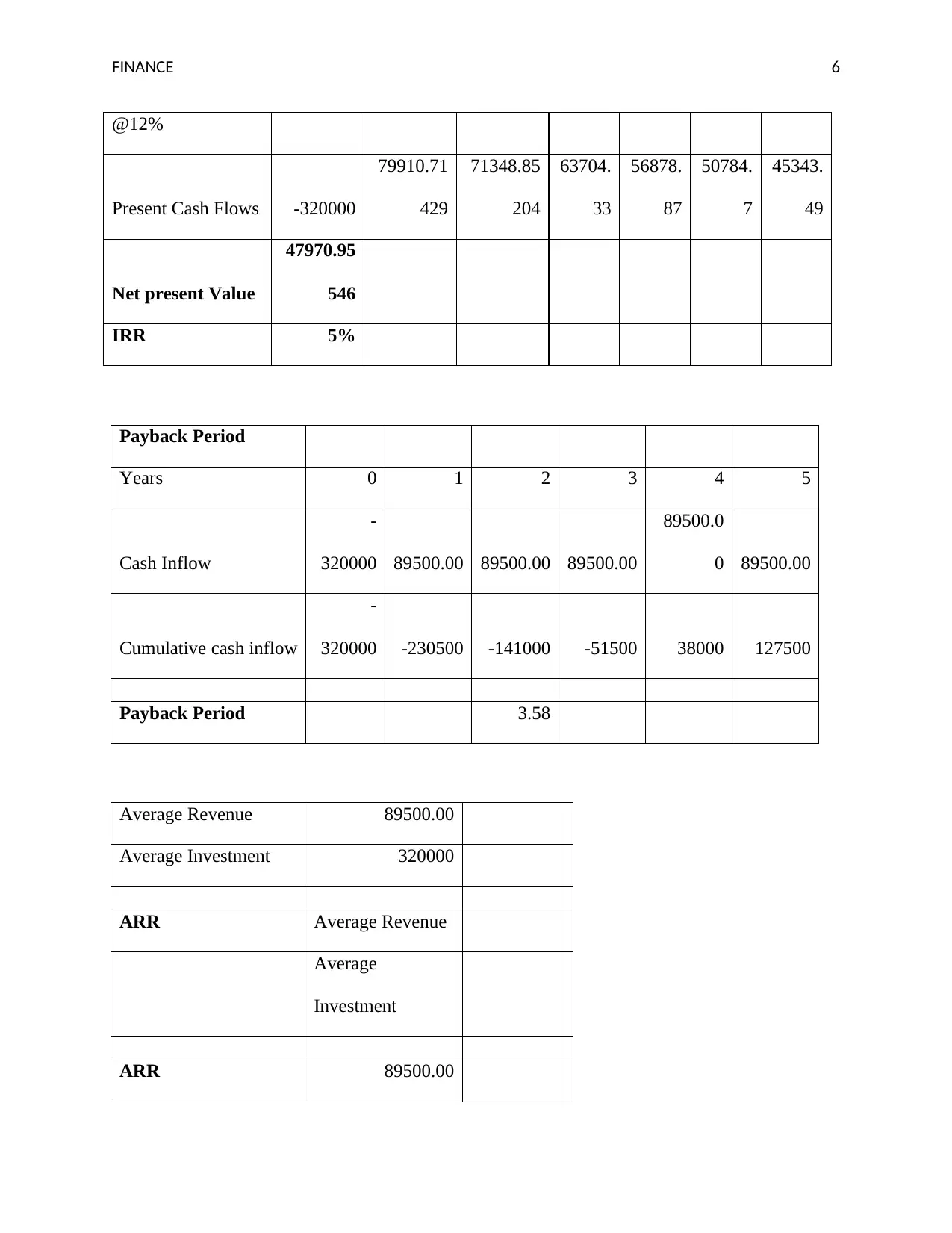
FINANCE 6
@12%
Present Cash Flows -320000
79910.71
429
71348.85
204
63704.
33
56878.
87
50784.
7
45343.
49
Net present Value
47970.95
546
IRR 5%
Payback Period
Years 0 1 2 3 4 5
Cash Inflow
-
320000 89500.00 89500.00 89500.00
89500.0
0 89500.00
Cumulative cash inflow
-
320000 -230500 -141000 -51500 38000 127500
Payback Period 3.58
Average Revenue 89500.00
Average Investment 320000
ARR Average Revenue
Average
Investment
ARR 89500.00
@12%
Present Cash Flows -320000
79910.71
429
71348.85
204
63704.
33
56878.
87
50784.
7
45343.
49
Net present Value
47970.95
546
IRR 5%
Payback Period
Years 0 1 2 3 4 5
Cash Inflow
-
320000 89500.00 89500.00 89500.00
89500.0
0 89500.00
Cumulative cash inflow
-
320000 -230500 -141000 -51500 38000 127500
Payback Period 3.58
Average Revenue 89500.00
Average Investment 320000
ARR Average Revenue
Average
Investment
ARR 89500.00
Paraphrase This Document
Need a fresh take? Get an instant paraphrase of this document with our AI Paraphraser
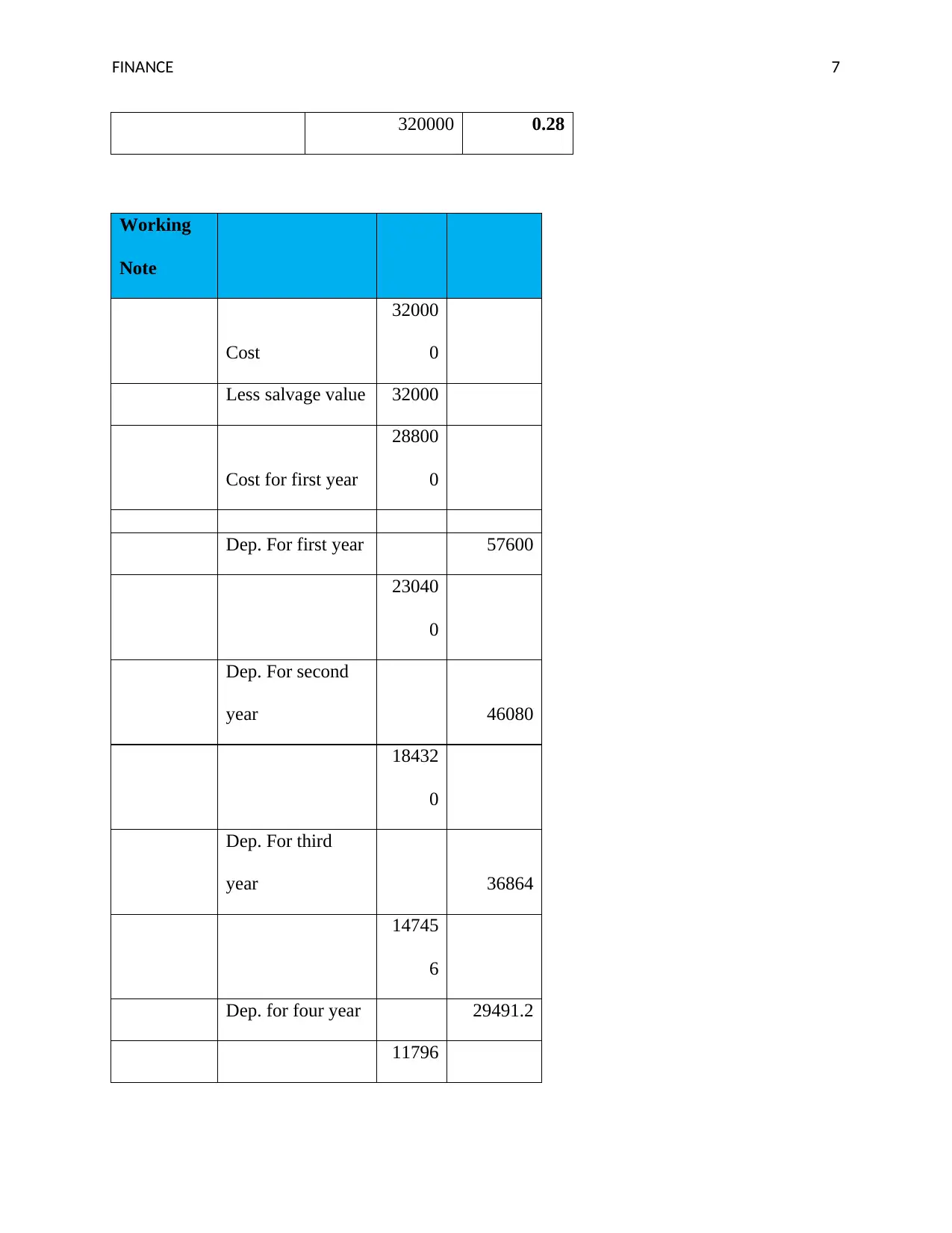
FINANCE 7
320000 0.28
Working
Note
Cost
32000
0
Less salvage value 32000
Cost for first year
28800
0
Dep. For first year 57600
23040
0
Dep. For second
year 46080
18432
0
Dep. For third
year 36864
14745
6
Dep. for four year 29491.2
11796
320000 0.28
Working
Note
Cost
32000
0
Less salvage value 32000
Cost for first year
28800
0
Dep. For first year 57600
23040
0
Dep. For second
year 46080
18432
0
Dep. For third
year 36864
14745
6
Dep. for four year 29491.2
11796
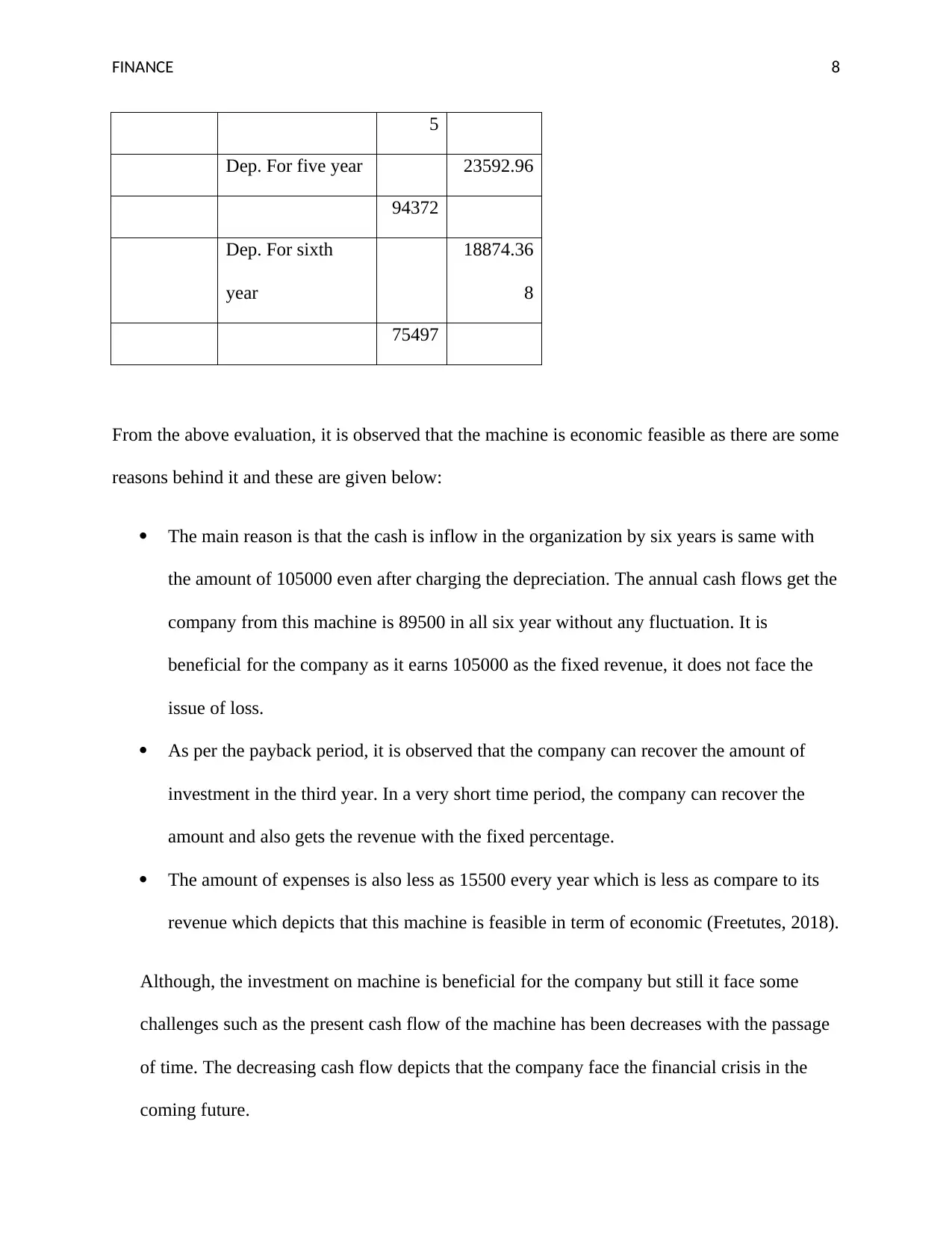
FINANCE 8
5
Dep. For five year 23592.96
94372
Dep. For sixth
year
18874.36
8
75497
From the above evaluation, it is observed that the machine is economic feasible as there are some
reasons behind it and these are given below:
The main reason is that the cash is inflow in the organization by six years is same with
the amount of 105000 even after charging the depreciation. The annual cash flows get the
company from this machine is 89500 in all six year without any fluctuation. It is
beneficial for the company as it earns 105000 as the fixed revenue, it does not face the
issue of loss.
As per the payback period, it is observed that the company can recover the amount of
investment in the third year. In a very short time period, the company can recover the
amount and also gets the revenue with the fixed percentage.
The amount of expenses is also less as 15500 every year which is less as compare to its
revenue which depicts that this machine is feasible in term of economic (Freetutes, 2018).
Although, the investment on machine is beneficial for the company but still it face some
challenges such as the present cash flow of the machine has been decreases with the passage
of time. The decreasing cash flow depicts that the company face the financial crisis in the
coming future.
5
Dep. For five year 23592.96
94372
Dep. For sixth
year
18874.36
8
75497
From the above evaluation, it is observed that the machine is economic feasible as there are some
reasons behind it and these are given below:
The main reason is that the cash is inflow in the organization by six years is same with
the amount of 105000 even after charging the depreciation. The annual cash flows get the
company from this machine is 89500 in all six year without any fluctuation. It is
beneficial for the company as it earns 105000 as the fixed revenue, it does not face the
issue of loss.
As per the payback period, it is observed that the company can recover the amount of
investment in the third year. In a very short time period, the company can recover the
amount and also gets the revenue with the fixed percentage.
The amount of expenses is also less as 15500 every year which is less as compare to its
revenue which depicts that this machine is feasible in term of economic (Freetutes, 2018).
Although, the investment on machine is beneficial for the company but still it face some
challenges such as the present cash flow of the machine has been decreases with the passage
of time. The decreasing cash flow depicts that the company face the financial crisis in the
coming future.
⊘ This is a preview!⊘
Do you want full access?
Subscribe today to unlock all pages.

Trusted by 1+ million students worldwide
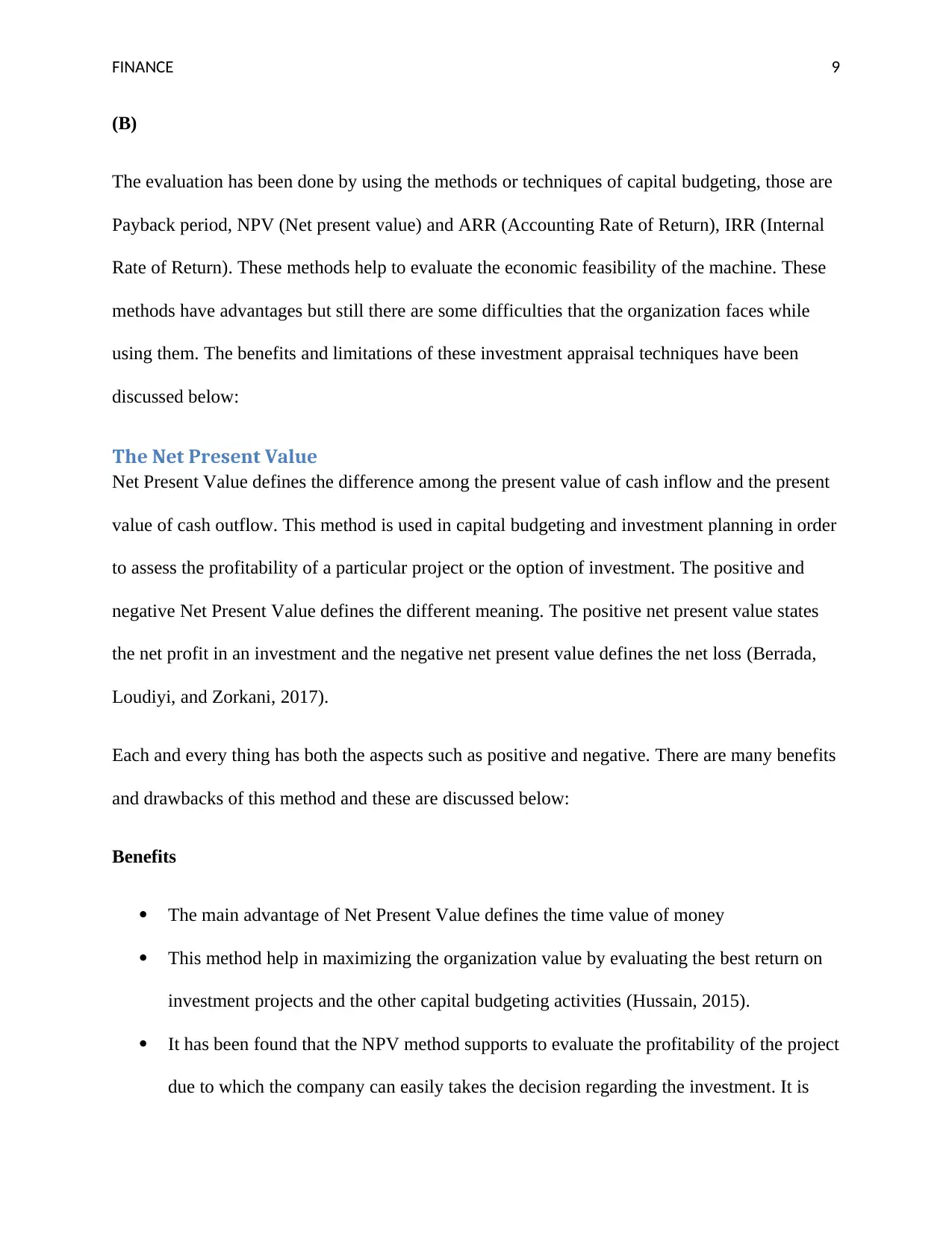
FINANCE 9
(B)
The evaluation has been done by using the methods or techniques of capital budgeting, those are
Payback period, NPV (Net present value) and ARR (Accounting Rate of Return), IRR (Internal
Rate of Return). These methods help to evaluate the economic feasibility of the machine. These
methods have advantages but still there are some difficulties that the organization faces while
using them. The benefits and limitations of these investment appraisal techniques have been
discussed below:
The Net Present Value
Net Present Value defines the difference among the present value of cash inflow and the present
value of cash outflow. This method is used in capital budgeting and investment planning in order
to assess the profitability of a particular project or the option of investment. The positive and
negative Net Present Value defines the different meaning. The positive net present value states
the net profit in an investment and the negative net present value defines the net loss (Berrada,
Loudiyi, and Zorkani, 2017).
Each and every thing has both the aspects such as positive and negative. There are many benefits
and drawbacks of this method and these are discussed below:
Benefits
The main advantage of Net Present Value defines the time value of money
This method help in maximizing the organization value by evaluating the best return on
investment projects and the other capital budgeting activities (Hussain, 2015).
It has been found that the NPV method supports to evaluate the profitability of the project
due to which the company can easily takes the decision regarding the investment. It is
(B)
The evaluation has been done by using the methods or techniques of capital budgeting, those are
Payback period, NPV (Net present value) and ARR (Accounting Rate of Return), IRR (Internal
Rate of Return). These methods help to evaluate the economic feasibility of the machine. These
methods have advantages but still there are some difficulties that the organization faces while
using them. The benefits and limitations of these investment appraisal techniques have been
discussed below:
The Net Present Value
Net Present Value defines the difference among the present value of cash inflow and the present
value of cash outflow. This method is used in capital budgeting and investment planning in order
to assess the profitability of a particular project or the option of investment. The positive and
negative Net Present Value defines the different meaning. The positive net present value states
the net profit in an investment and the negative net present value defines the net loss (Berrada,
Loudiyi, and Zorkani, 2017).
Each and every thing has both the aspects such as positive and negative. There are many benefits
and drawbacks of this method and these are discussed below:
Benefits
The main advantage of Net Present Value defines the time value of money
This method help in maximizing the organization value by evaluating the best return on
investment projects and the other capital budgeting activities (Hussain, 2015).
It has been found that the NPV method supports to evaluate the profitability of the project
due to which the company can easily takes the decision regarding the investment. It is
Paraphrase This Document
Need a fresh take? Get an instant paraphrase of this document with our AI Paraphraser
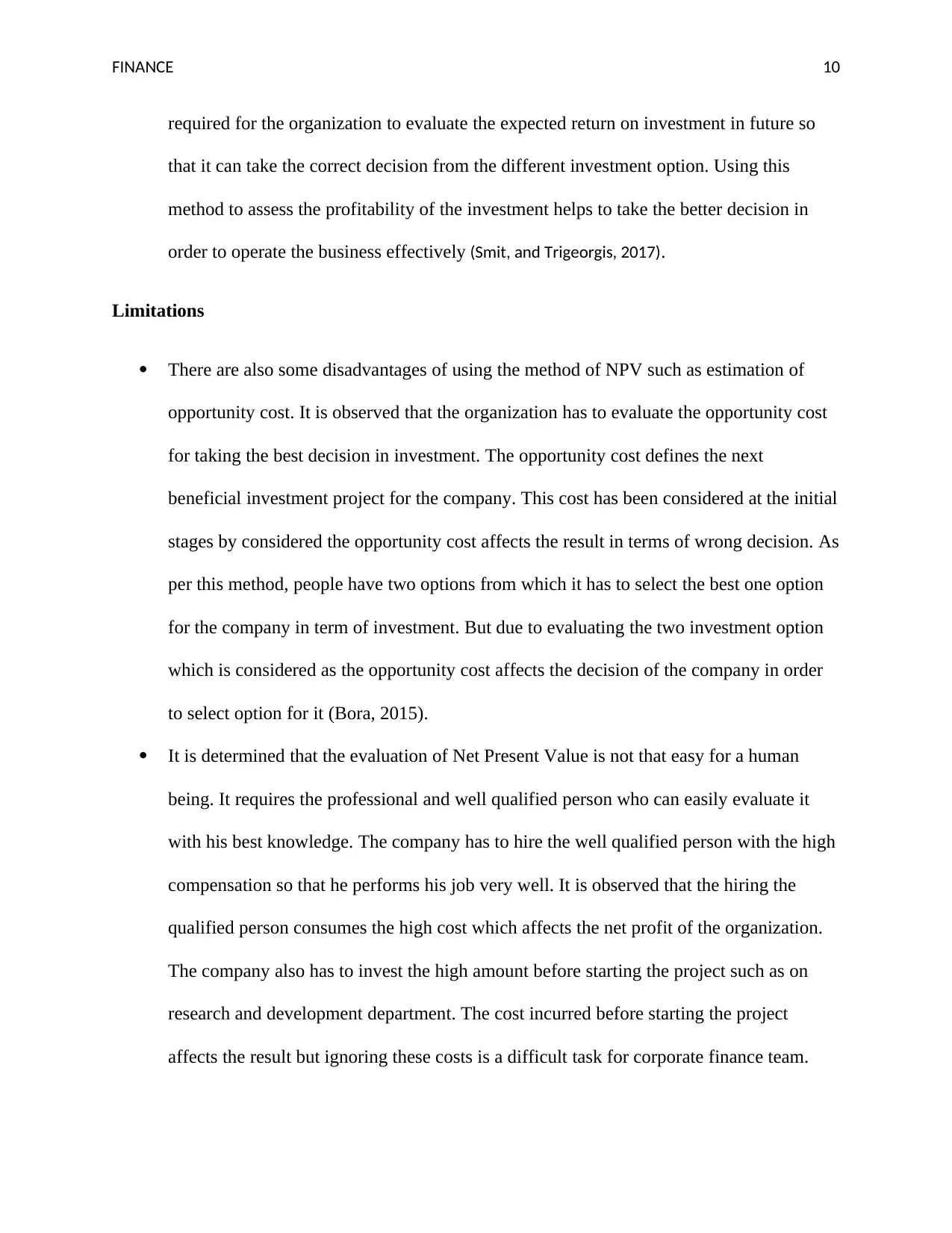
FINANCE 10
required for the organization to evaluate the expected return on investment in future so
that it can take the correct decision from the different investment option. Using this
method to assess the profitability of the investment helps to take the better decision in
order to operate the business effectively (Smit, and Trigeorgis, 2017).
Limitations
There are also some disadvantages of using the method of NPV such as estimation of
opportunity cost. It is observed that the organization has to evaluate the opportunity cost
for taking the best decision in investment. The opportunity cost defines the next
beneficial investment project for the company. This cost has been considered at the initial
stages by considered the opportunity cost affects the result in terms of wrong decision. As
per this method, people have two options from which it has to select the best one option
for the company in term of investment. But due to evaluating the two investment option
which is considered as the opportunity cost affects the decision of the company in order
to select option for it (Bora, 2015).
It is determined that the evaluation of Net Present Value is not that easy for a human
being. It requires the professional and well qualified person who can easily evaluate it
with his best knowledge. The company has to hire the well qualified person with the high
compensation so that he performs his job very well. It is observed that the hiring the
qualified person consumes the high cost which affects the net profit of the organization.
The company also has to invest the high amount before starting the project such as on
research and development department. The cost incurred before starting the project
affects the result but ignoring these costs is a difficult task for corporate finance team.
required for the organization to evaluate the expected return on investment in future so
that it can take the correct decision from the different investment option. Using this
method to assess the profitability of the investment helps to take the better decision in
order to operate the business effectively (Smit, and Trigeorgis, 2017).
Limitations
There are also some disadvantages of using the method of NPV such as estimation of
opportunity cost. It is observed that the organization has to evaluate the opportunity cost
for taking the best decision in investment. The opportunity cost defines the next
beneficial investment project for the company. This cost has been considered at the initial
stages by considered the opportunity cost affects the result in terms of wrong decision. As
per this method, people have two options from which it has to select the best one option
for the company in term of investment. But due to evaluating the two investment option
which is considered as the opportunity cost affects the decision of the company in order
to select option for it (Bora, 2015).
It is determined that the evaluation of Net Present Value is not that easy for a human
being. It requires the professional and well qualified person who can easily evaluate it
with his best knowledge. The company has to hire the well qualified person with the high
compensation so that he performs his job very well. It is observed that the hiring the
qualified person consumes the high cost which affects the net profit of the organization.
The company also has to invest the high amount before starting the project such as on
research and development department. The cost incurred before starting the project
affects the result but ignoring these costs is a difficult task for corporate finance team.
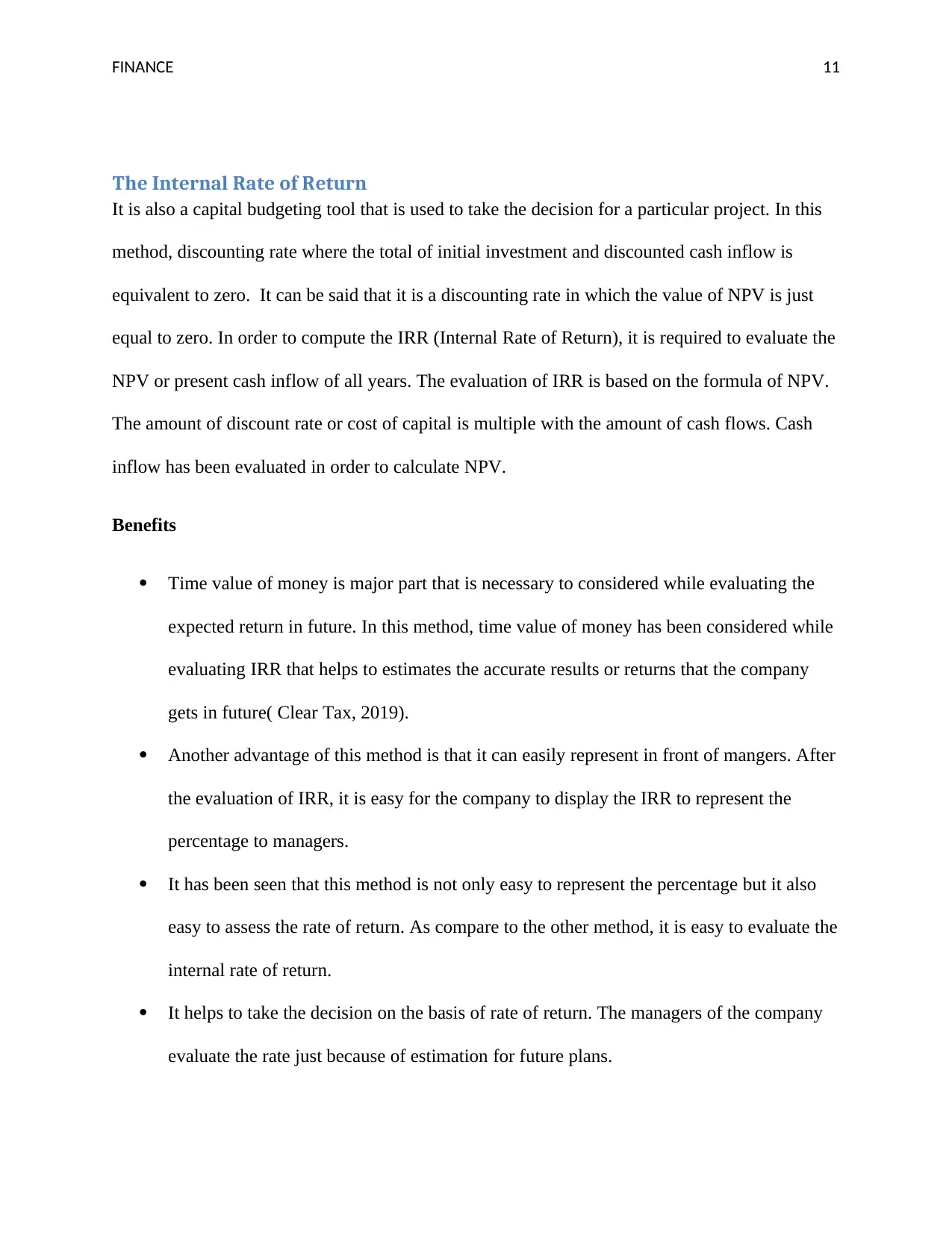
FINANCE 11
The Internal Rate of Return
It is also a capital budgeting tool that is used to take the decision for a particular project. In this
method, discounting rate where the total of initial investment and discounted cash inflow is
equivalent to zero. It can be said that it is a discounting rate in which the value of NPV is just
equal to zero. In order to compute the IRR (Internal Rate of Return), it is required to evaluate the
NPV or present cash inflow of all years. The evaluation of IRR is based on the formula of NPV.
The amount of discount rate or cost of capital is multiple with the amount of cash flows. Cash
inflow has been evaluated in order to calculate NPV.
Benefits
Time value of money is major part that is necessary to considered while evaluating the
expected return in future. In this method, time value of money has been considered while
evaluating IRR that helps to estimates the accurate results or returns that the company
gets in future( Clear Tax, 2019).
Another advantage of this method is that it can easily represent in front of mangers. After
the evaluation of IRR, it is easy for the company to display the IRR to represent the
percentage to managers.
It has been seen that this method is not only easy to represent the percentage but it also
easy to assess the rate of return. As compare to the other method, it is easy to evaluate the
internal rate of return.
It helps to take the decision on the basis of rate of return. The managers of the company
evaluate the rate just because of estimation for future plans.
The Internal Rate of Return
It is also a capital budgeting tool that is used to take the decision for a particular project. In this
method, discounting rate where the total of initial investment and discounted cash inflow is
equivalent to zero. It can be said that it is a discounting rate in which the value of NPV is just
equal to zero. In order to compute the IRR (Internal Rate of Return), it is required to evaluate the
NPV or present cash inflow of all years. The evaluation of IRR is based on the formula of NPV.
The amount of discount rate or cost of capital is multiple with the amount of cash flows. Cash
inflow has been evaluated in order to calculate NPV.
Benefits
Time value of money is major part that is necessary to considered while evaluating the
expected return in future. In this method, time value of money has been considered while
evaluating IRR that helps to estimates the accurate results or returns that the company
gets in future( Clear Tax, 2019).
Another advantage of this method is that it can easily represent in front of mangers. After
the evaluation of IRR, it is easy for the company to display the IRR to represent the
percentage to managers.
It has been seen that this method is not only easy to represent the percentage but it also
easy to assess the rate of return. As compare to the other method, it is easy to evaluate the
internal rate of return.
It helps to take the decision on the basis of rate of return. The managers of the company
evaluate the rate just because of estimation for future plans.
⊘ This is a preview!⊘
Do you want full access?
Subscribe today to unlock all pages.

Trusted by 1+ million students worldwide
1 out of 18
Related Documents
Your All-in-One AI-Powered Toolkit for Academic Success.
+13062052269
info@desklib.com
Available 24*7 on WhatsApp / Email
![[object Object]](/_next/static/media/star-bottom.7253800d.svg)
Unlock your academic potential
Copyright © 2020–2025 A2Z Services. All Rights Reserved. Developed and managed by ZUCOL.




